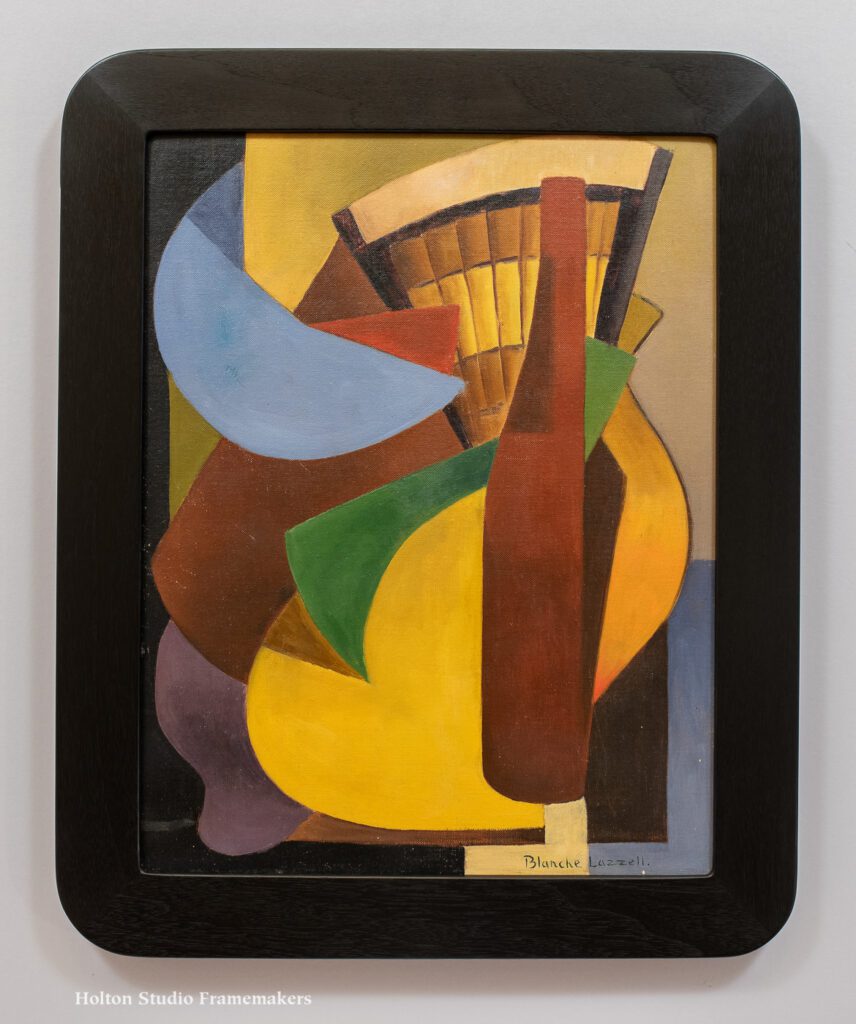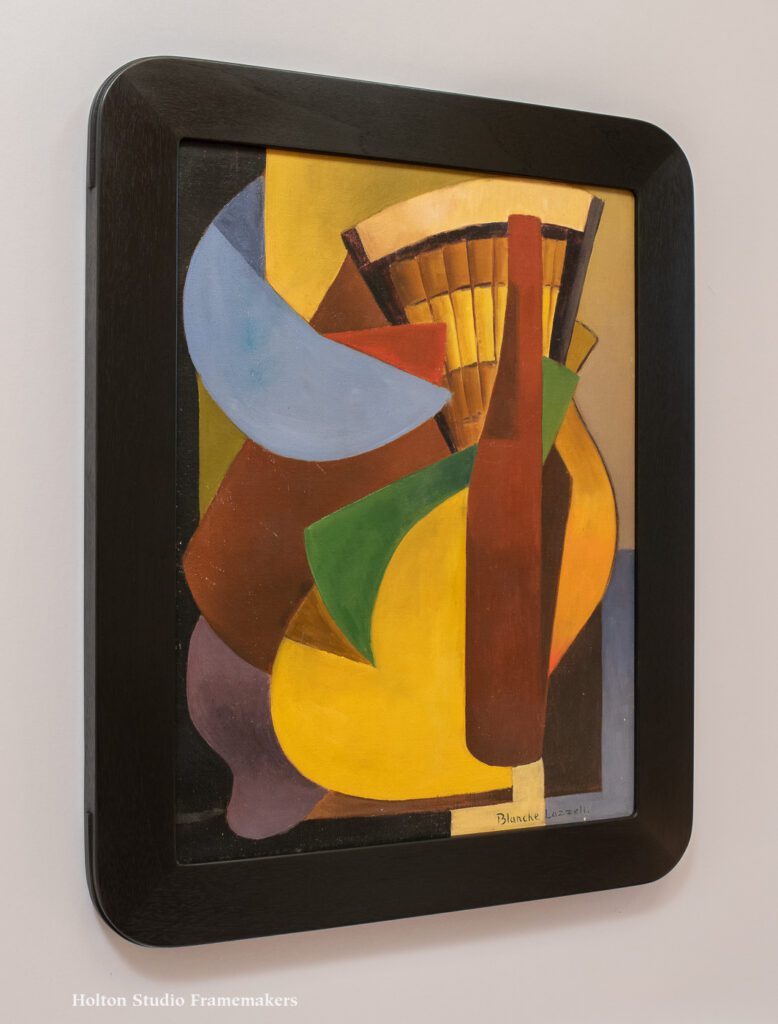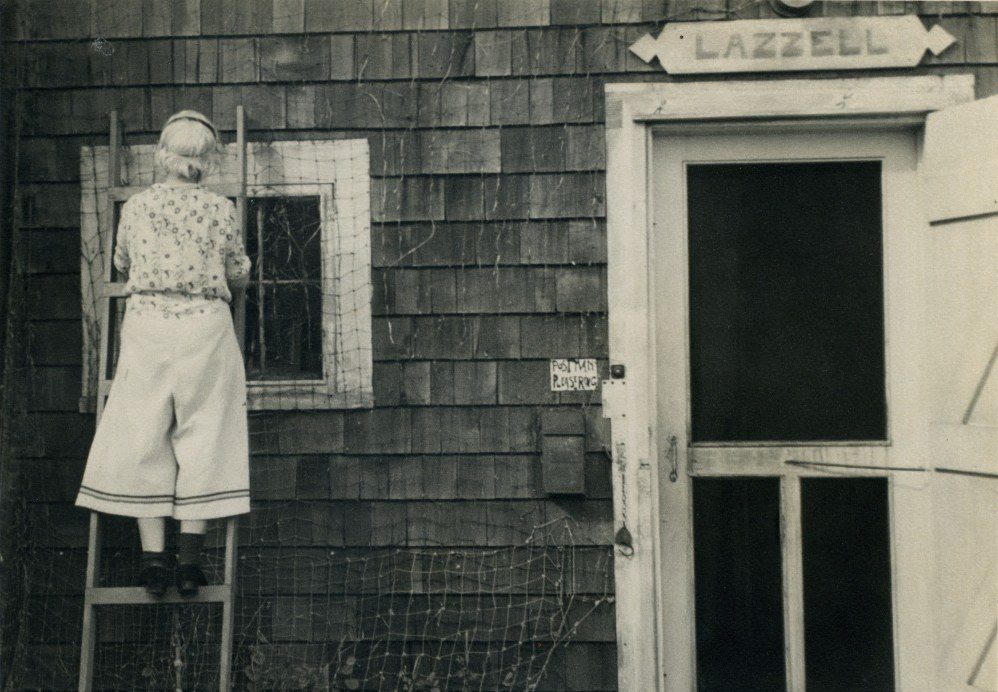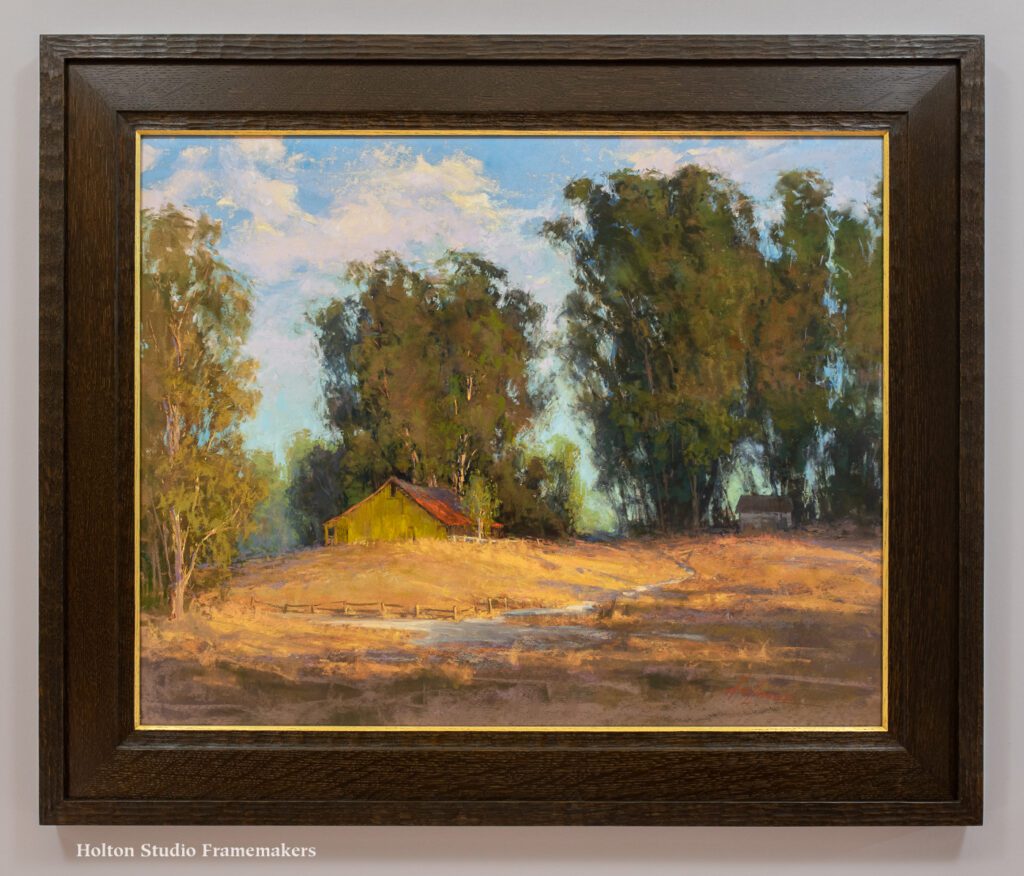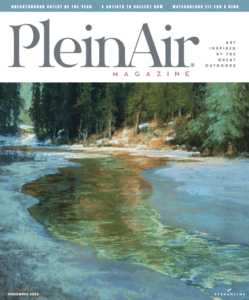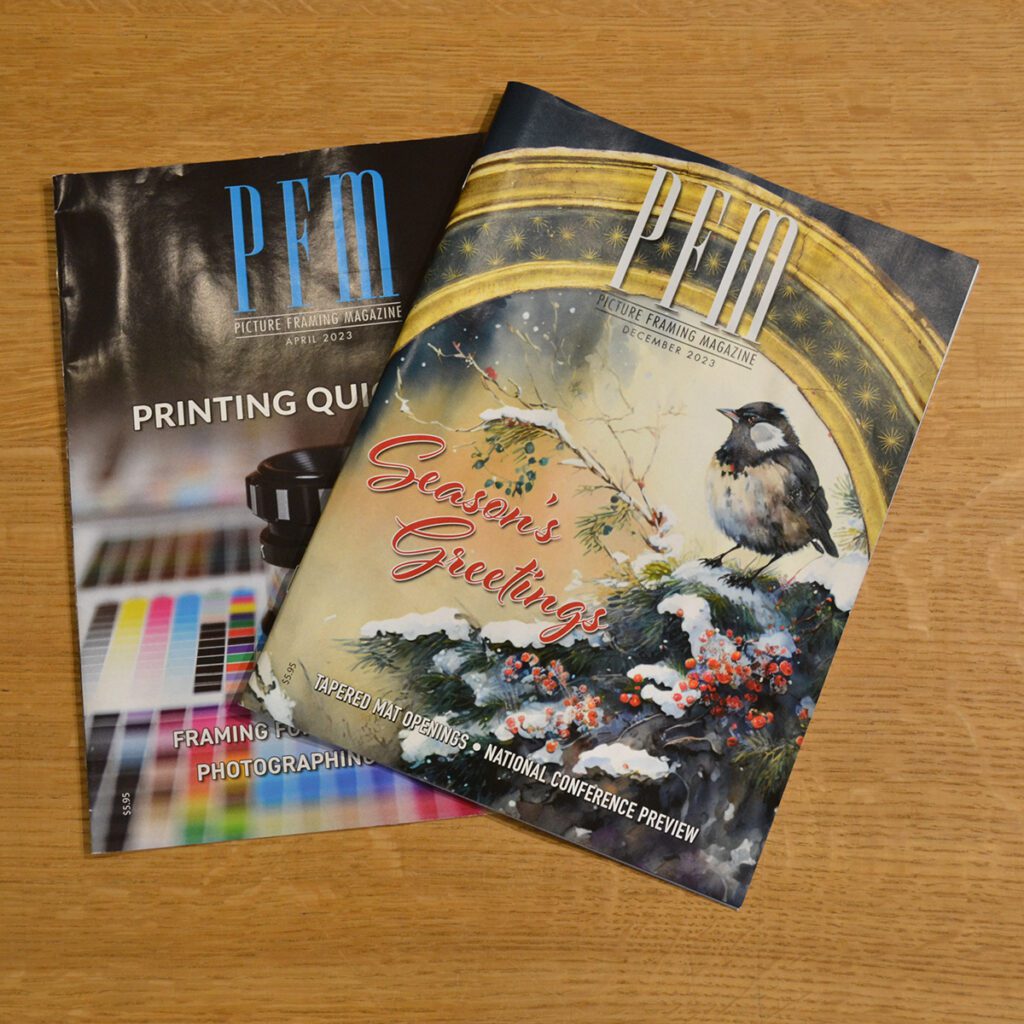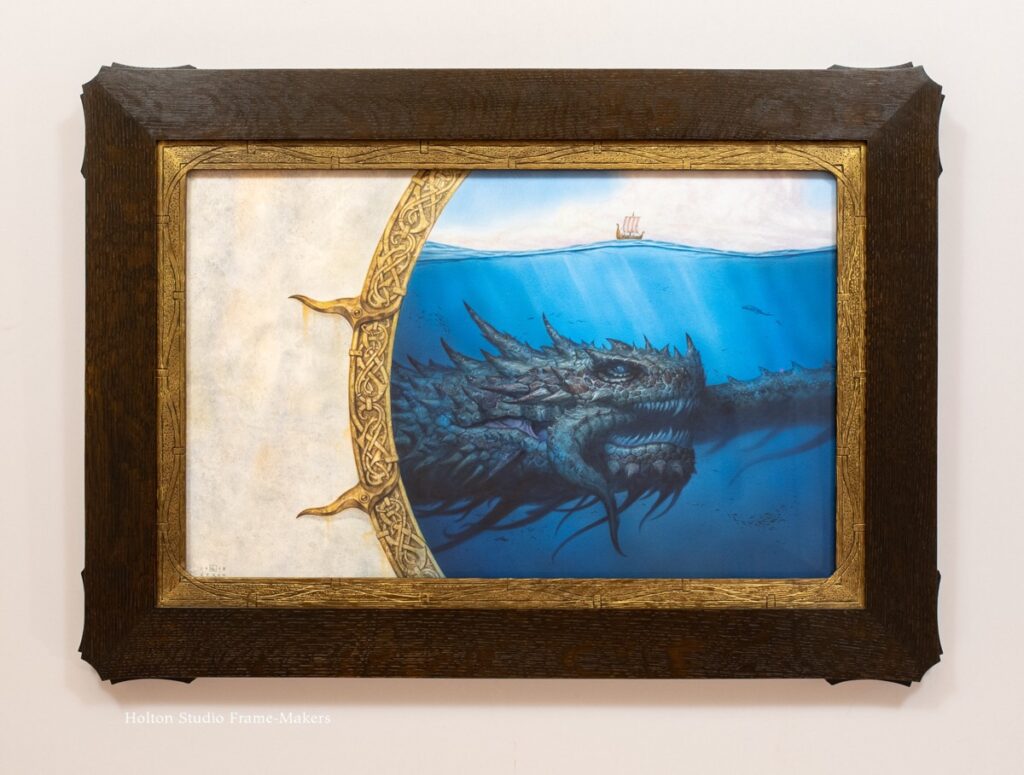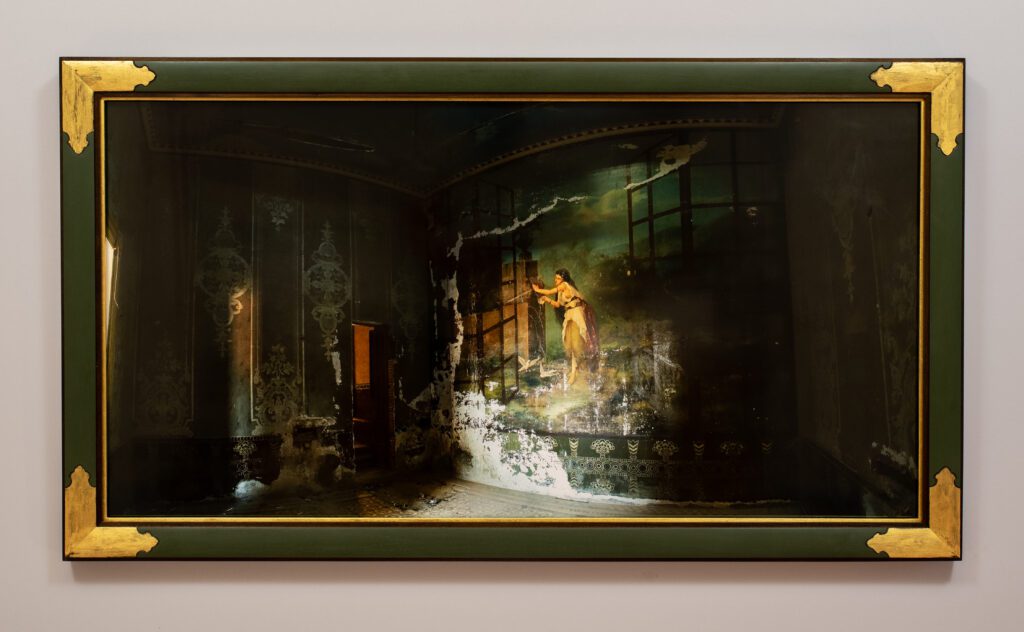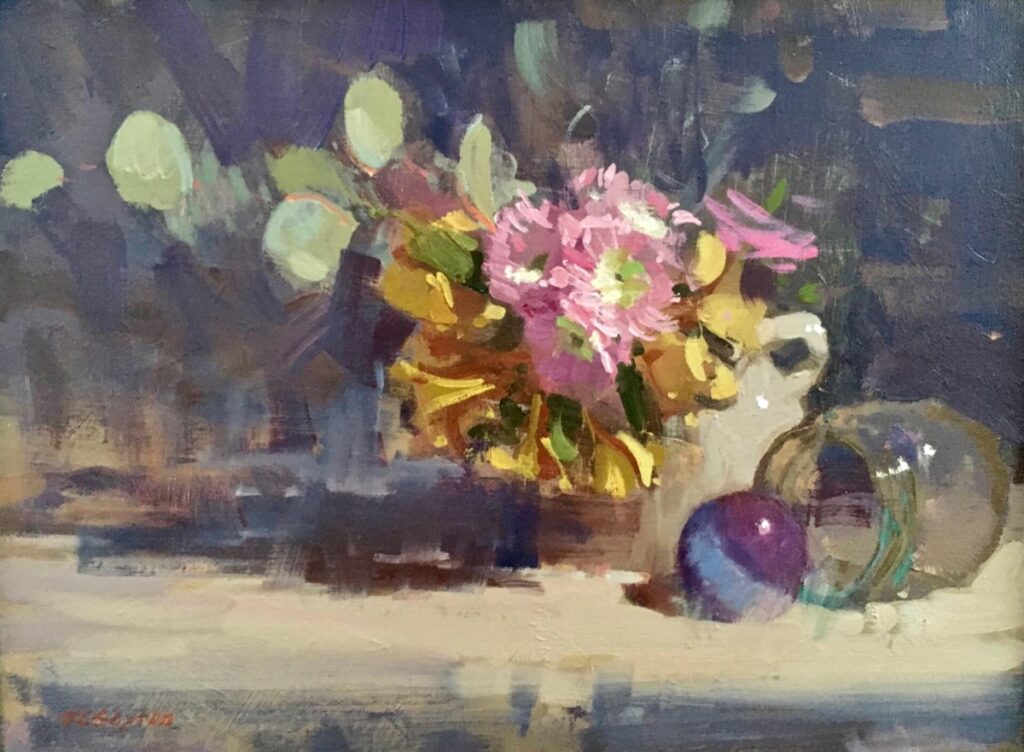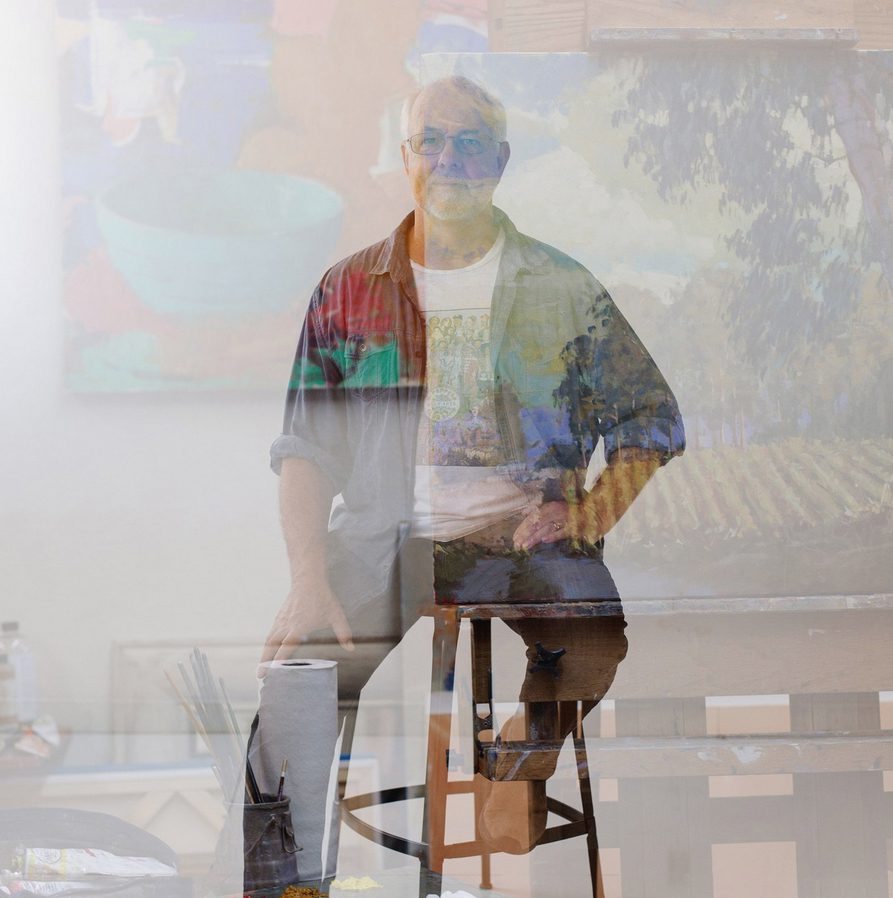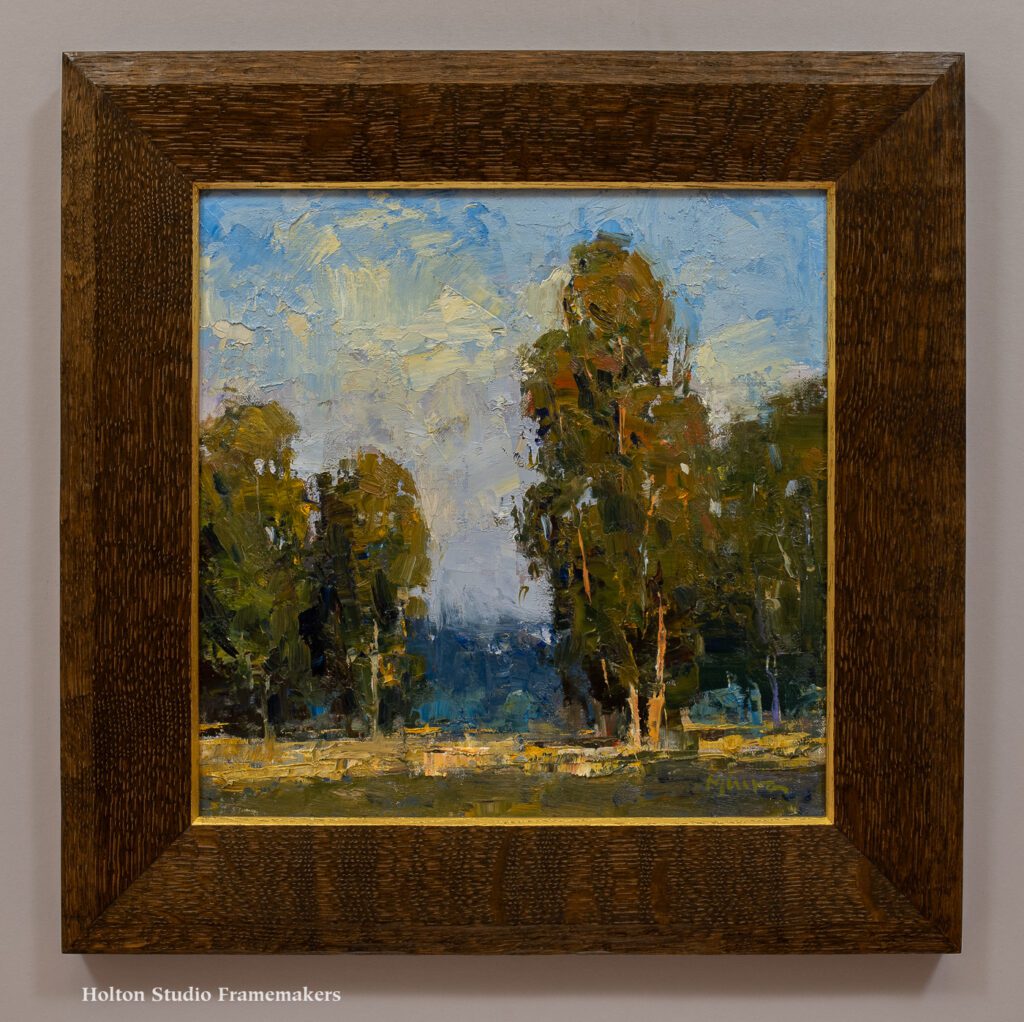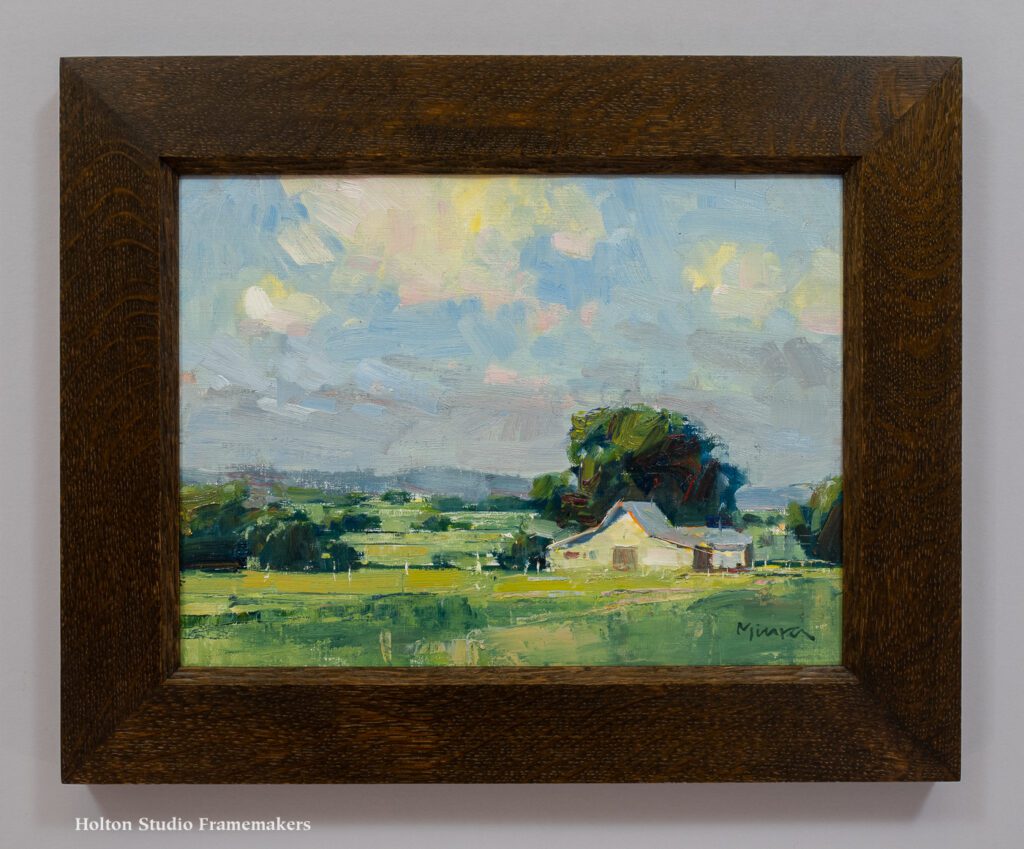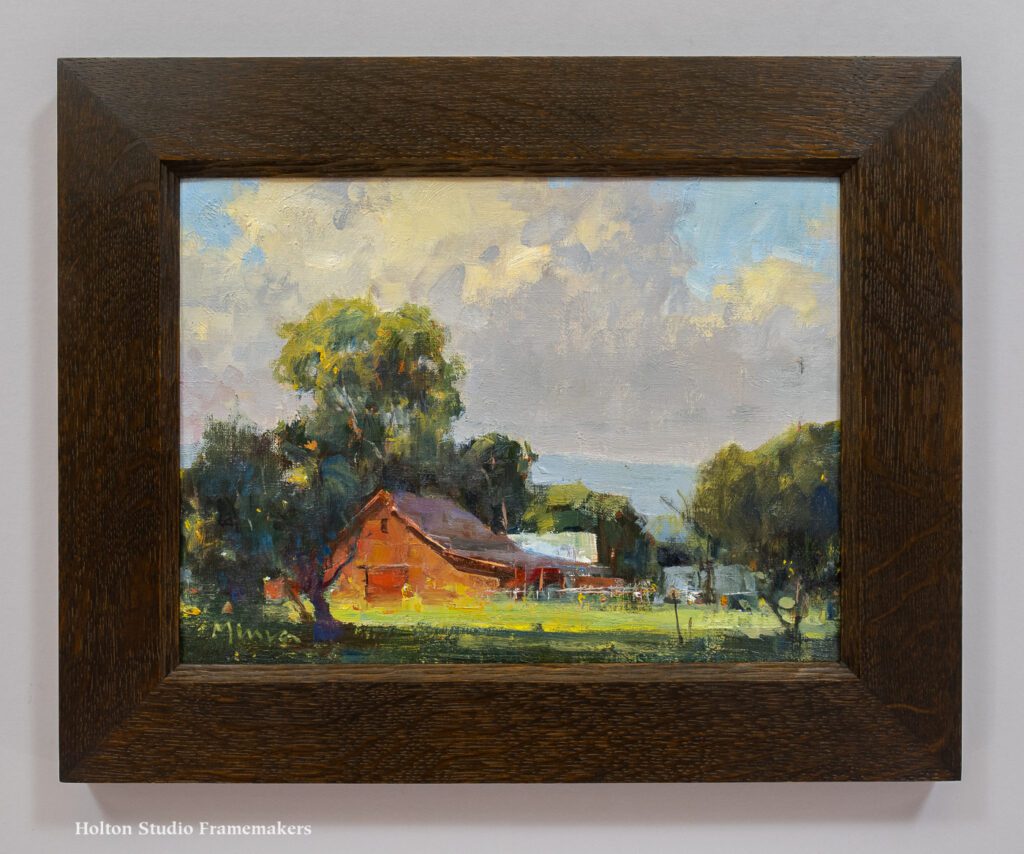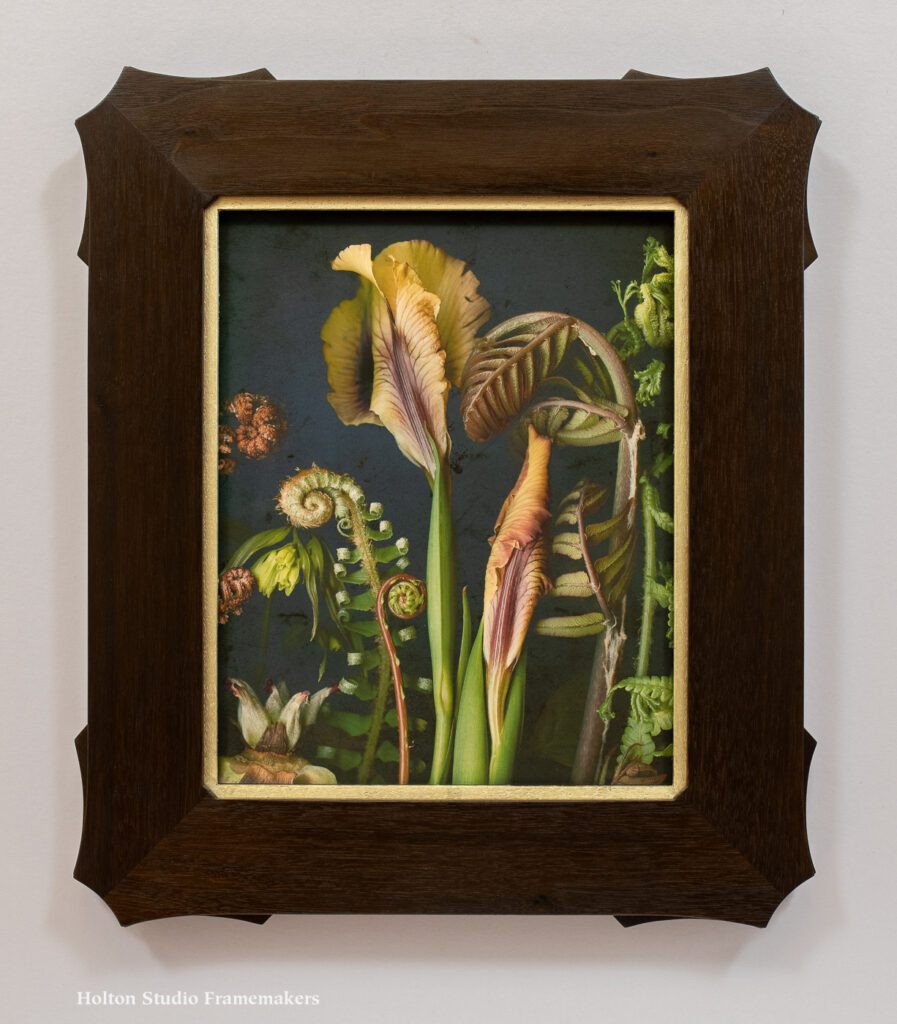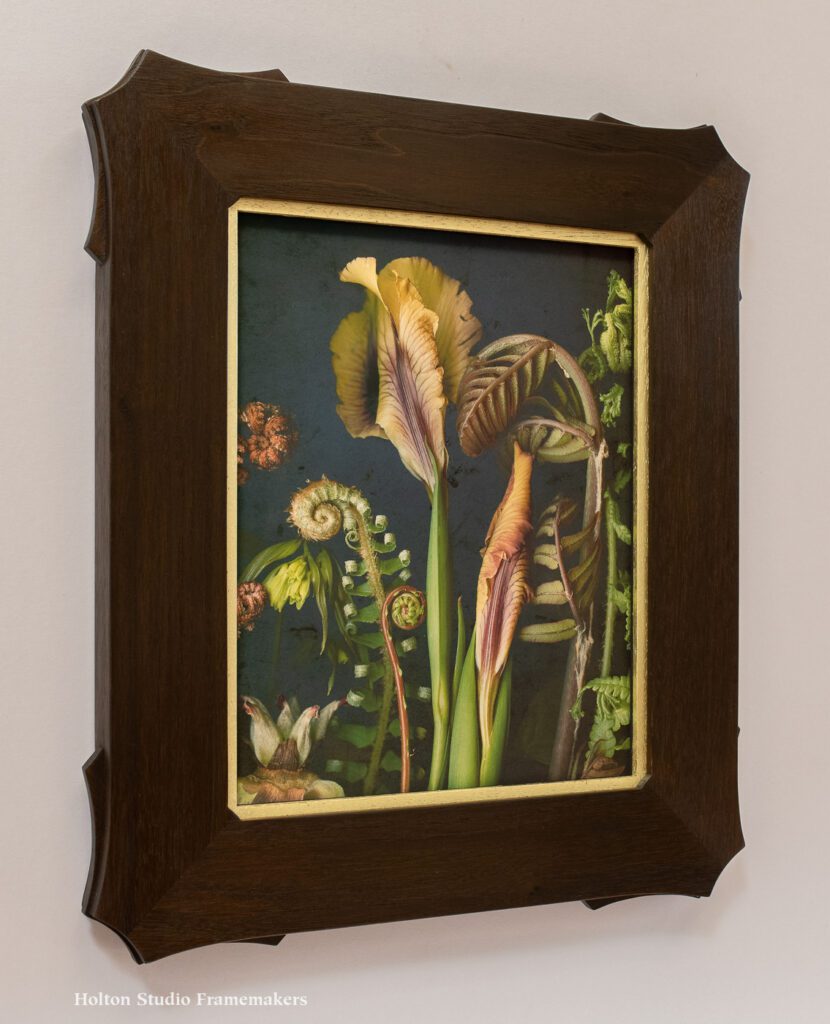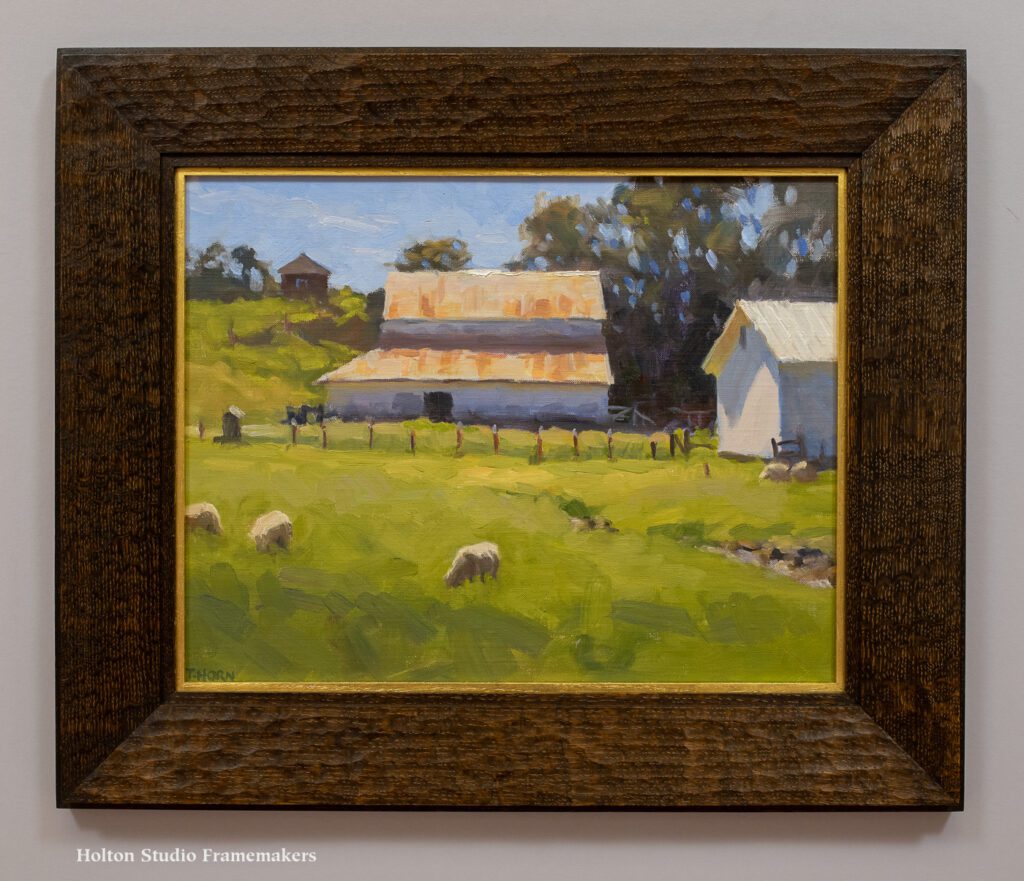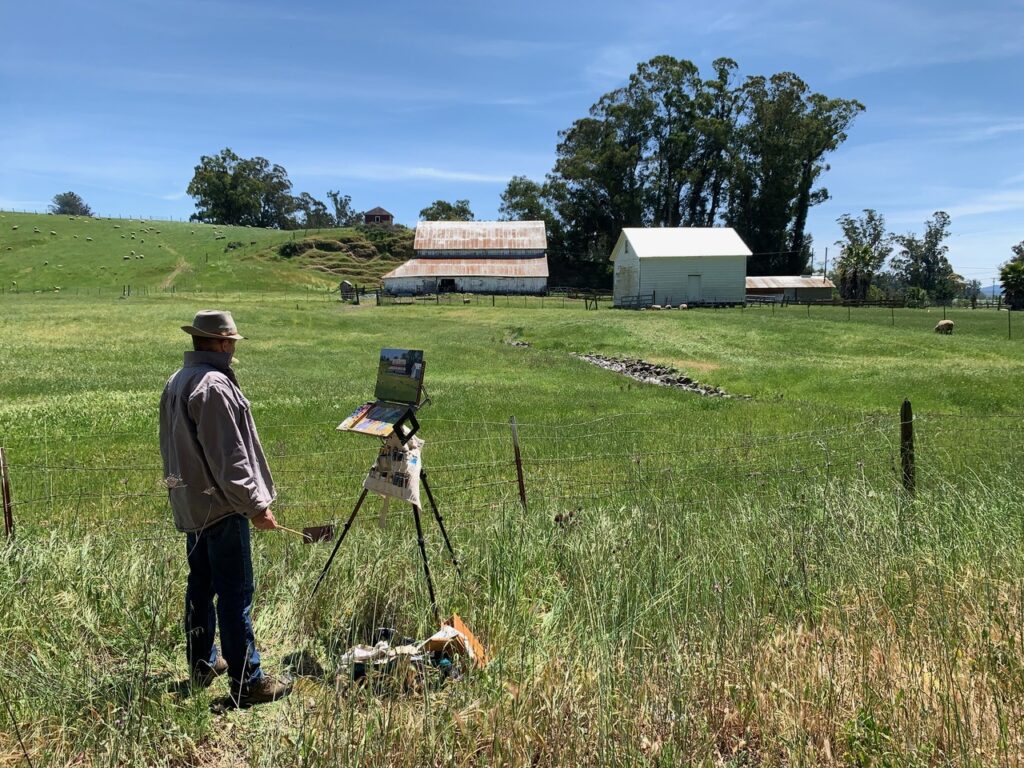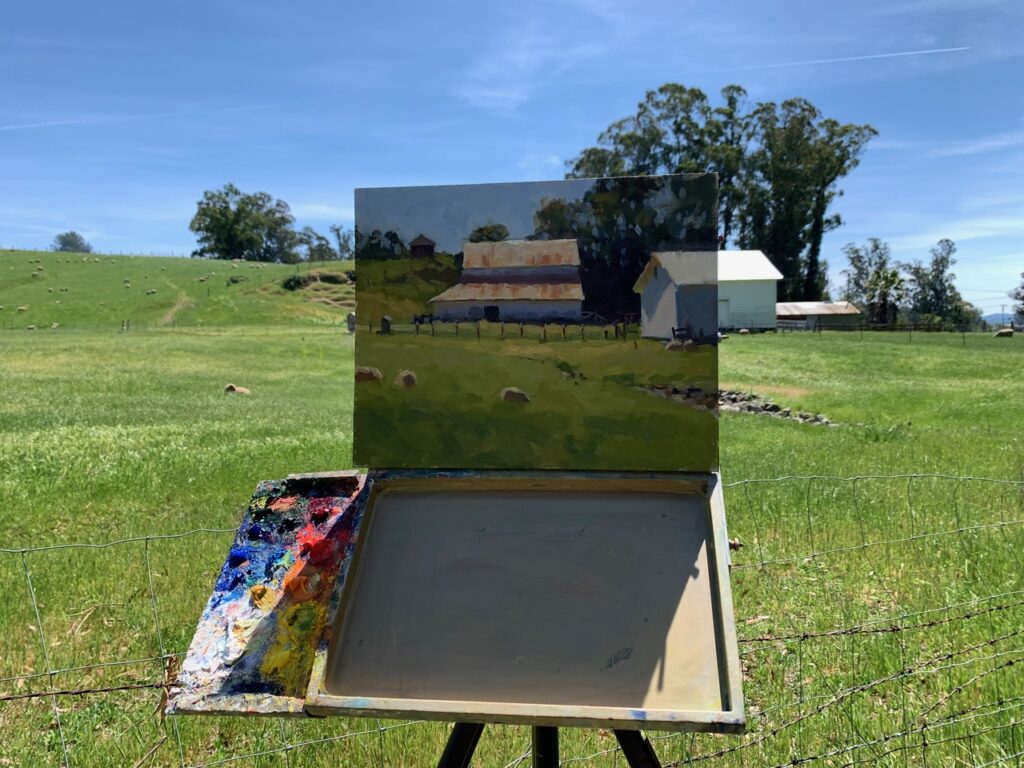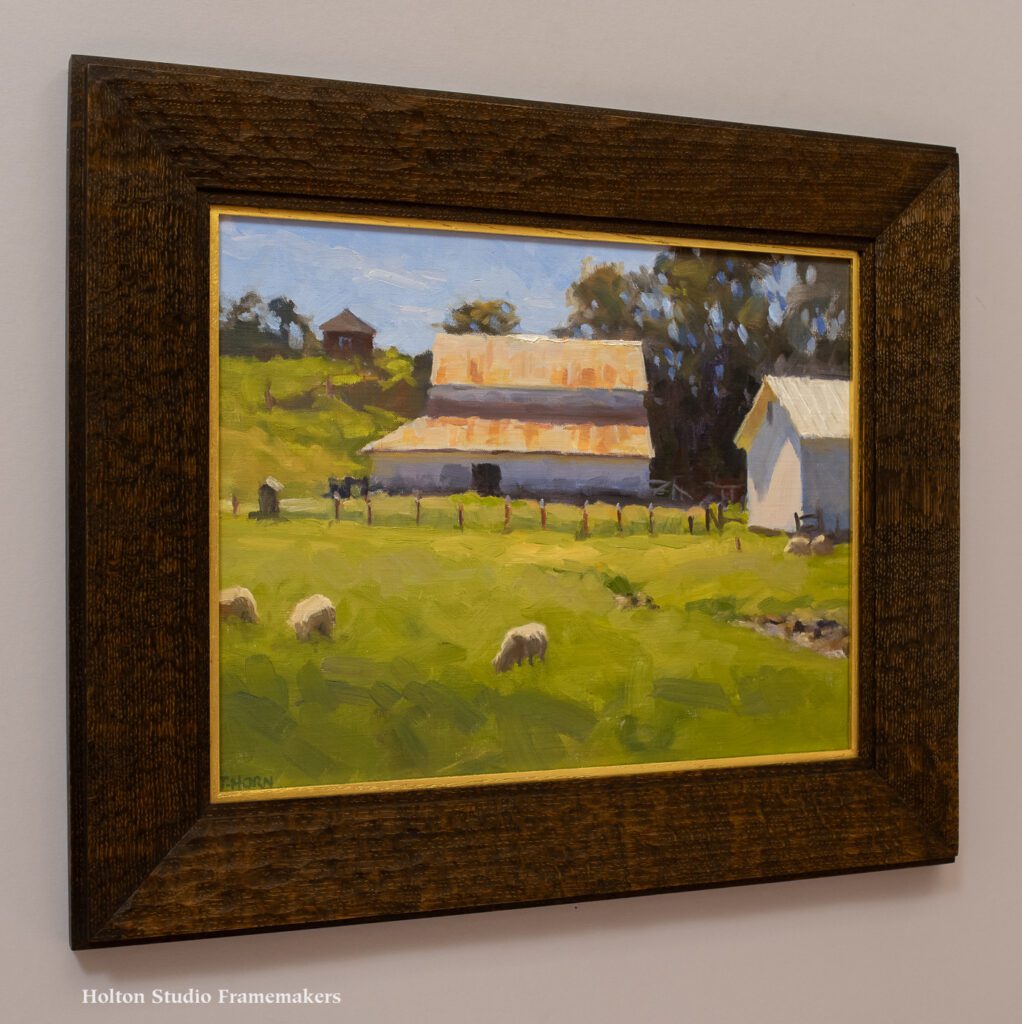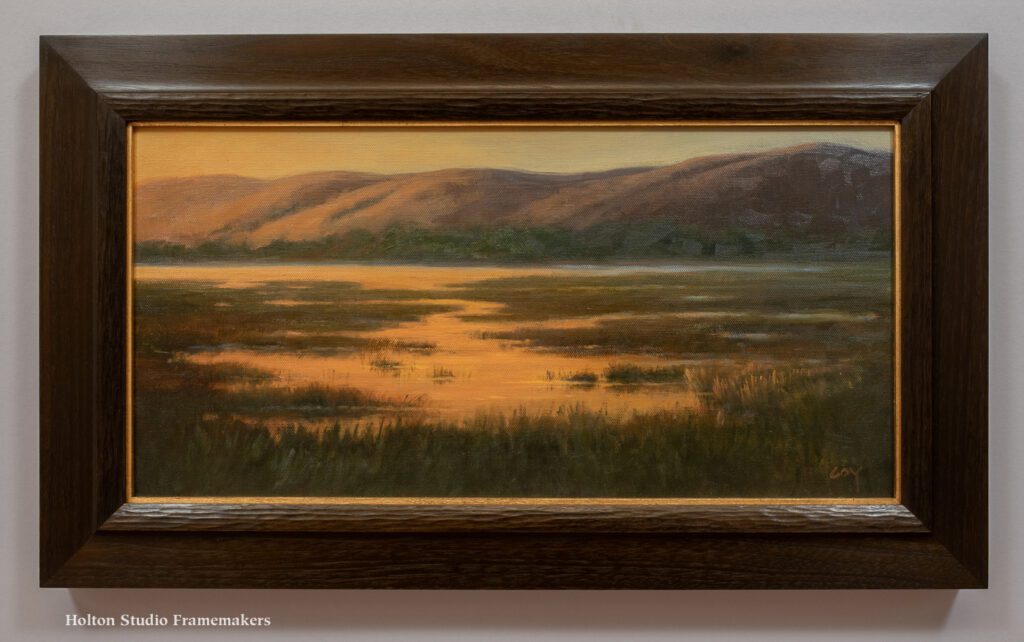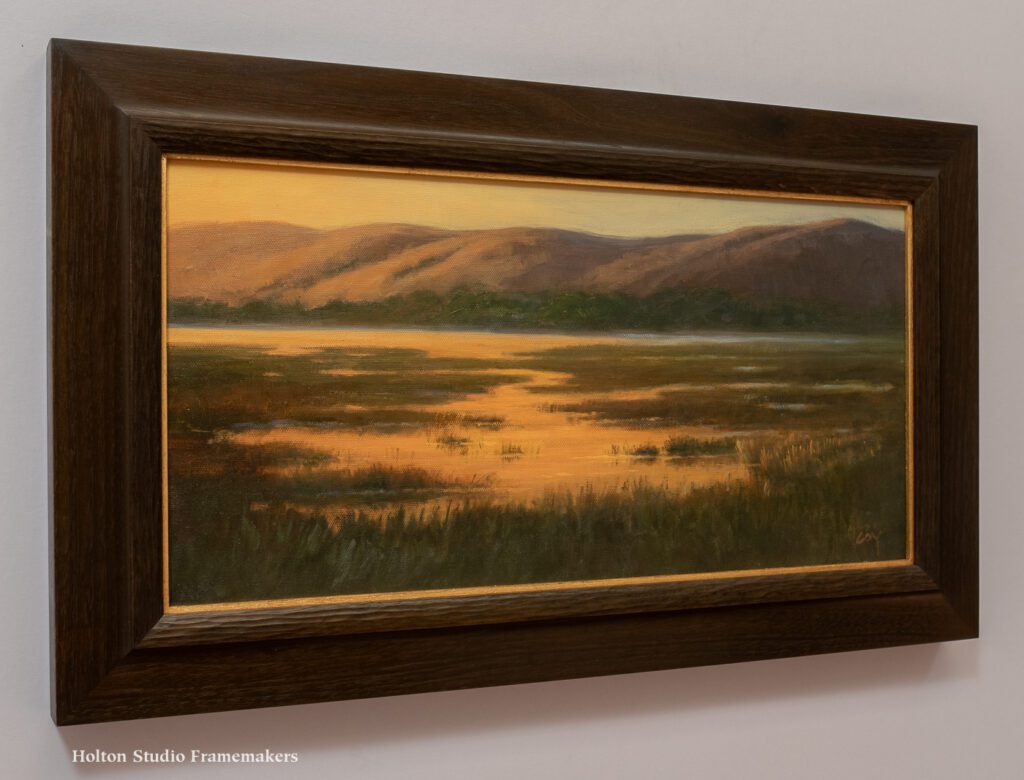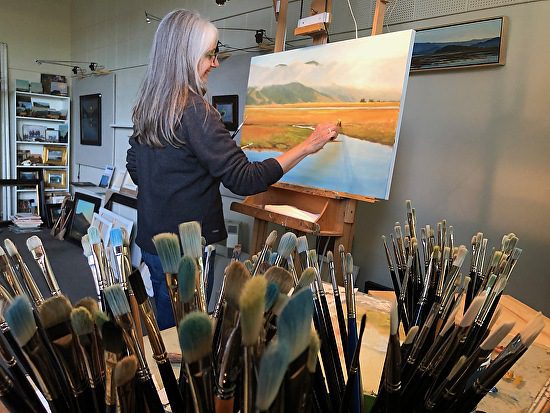I founded Holton Studio in 1993, so as we roll in to 2024, I’m not just celebrating a new year but these thirty years of business. And, lonely as may I look in this picture from the early days on Doyle Street in Emeryville, I’m happily embarking on my pursuit of the art of the picture frame with my attention in the right place: the joinery of my frames. 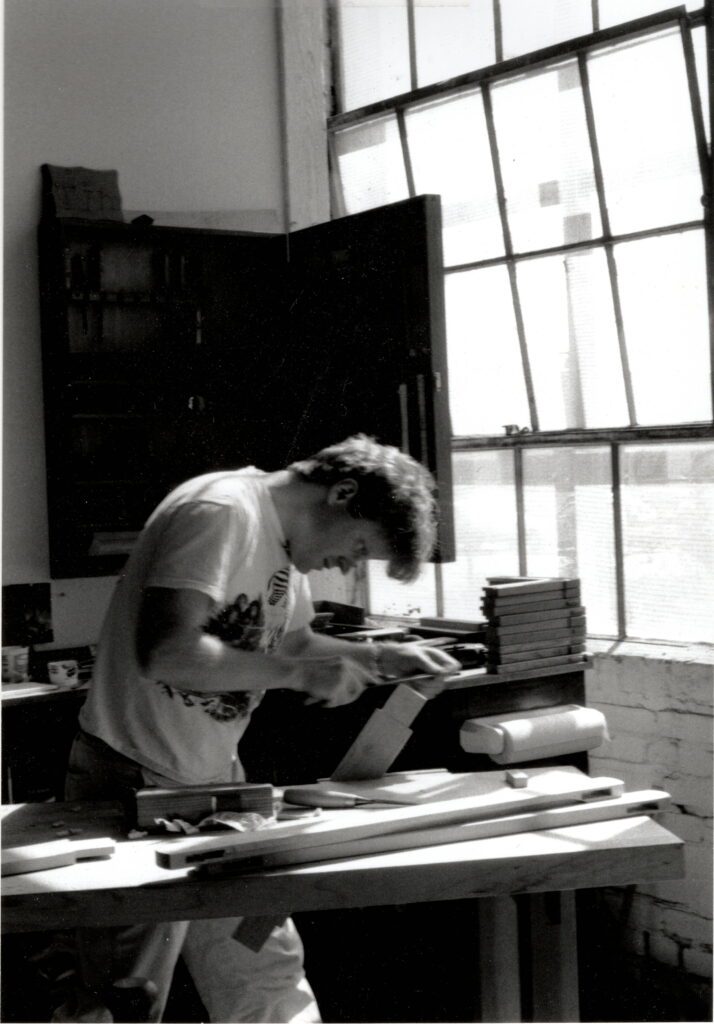 I’ve grasped an understanding of art, not as something complicated, lofty, and aloof but a simple thing rooted in the materials of the Earth and the work of everyday life, applying not only to pictures but to picture frames and to everything people do well; the word for which is rooted, as Webster’s explains, in the Latin ar-: “to join, fit together.” And in that, I’ve found the root of all the good things to come.
I’ve grasped an understanding of art, not as something complicated, lofty, and aloof but a simple thing rooted in the materials of the Earth and the work of everyday life, applying not only to pictures but to picture frames and to everything people do well; the word for which is rooted, as Webster’s explains, in the Latin ar-: “to join, fit together.” And in that, I’ve found the root of all the good things to come.
So, today I’m celebrating those thirty years with a whole lot of people in mind, many and diverse lives and efforts joined with mine in this enterprise; all those who’ve been with me—especially my wife, Stephanie, daughter, Ella, and my whole family—and whom I’ve worked with to put together all these years in business: with my customers (who include some true friends, and some of the most delightful, creative people I’ve ever known), with the Gallery‘s roster of artists, and with my co-workers—beginning with Trevor Davis who started working with me more than 25 years ago. The day I hired Trevor is the day the Studio’s vision, our unique model for a custom framing business, began to come together. With Trevor’s unshakeable commitment to sound joinery and craftsmanship, we fashioned the core principle that a picture can only be well-framed if it’s in a well-made frame. He also brought good business judgment and a great artistic eye.
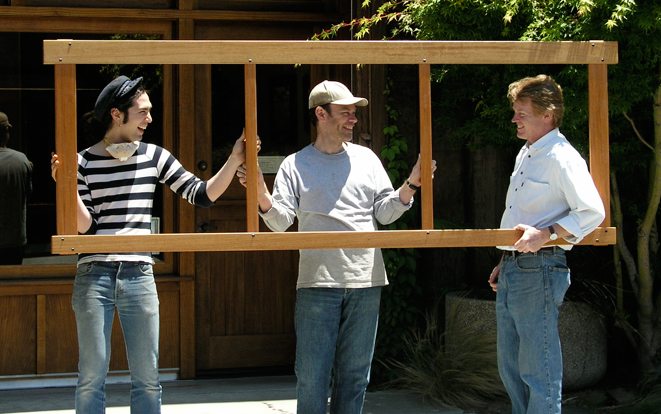 The conventional model for a frame shop is fairly “easy-entry,” in business lingo. Not so our model. Designing and making all of our frames from scratch, we did it the hard way. To do all that work, Trevor and I needed help, and Eric Johnson came along to provide it. Working with those two guys (and many others who, whether or not they stuck around, contributed), we’d gathered the parts for what we felt could be a pretty solid business—if we could just put them together with the right location.
The conventional model for a frame shop is fairly “easy-entry,” in business lingo. Not so our model. Designing and making all of our frames from scratch, we did it the hard way. To do all that work, Trevor and I needed help, and Eric Johnson came along to provide it. Working with those two guys (and many others who, whether or not they stuck around, contributed), we’d gathered the parts for what we felt could be a pretty solid business—if we could just put them together with the right location.
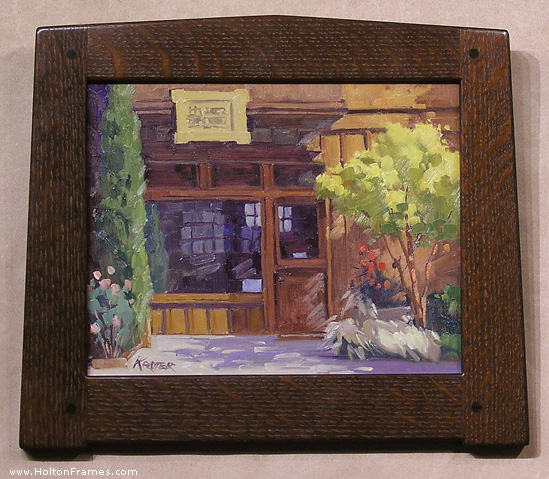
Paul Kratter’s painting of our storefront in Emeryville
In 2006, we took a big step in that direction when we leased a small space across Doyle Street where we could have a proper, though small, gallery. Showing the landscape paintings of artists we’d come to admire, starting with Robert Flanary, Paul Kratter, and Robin Moore, we gained the invaluable experience of working with painters and exceptional contemporary paintings. It created the basis of relationships that advanced considerably our understanding of the nuances of our work—of the harmony possible between picture and frame; and, with the frame, joining the picture to its larger setting and the lives lived in it; and, with these paintings of the land, re-joining in some measure our lives with the life of the Earth. With the gallery, we’ve developed lasting friendships—and not only with our painters but also, as the gallery became a gathering place, with a growing group of fellow admirers of California’s landscape its thriving landscape painting tradition.
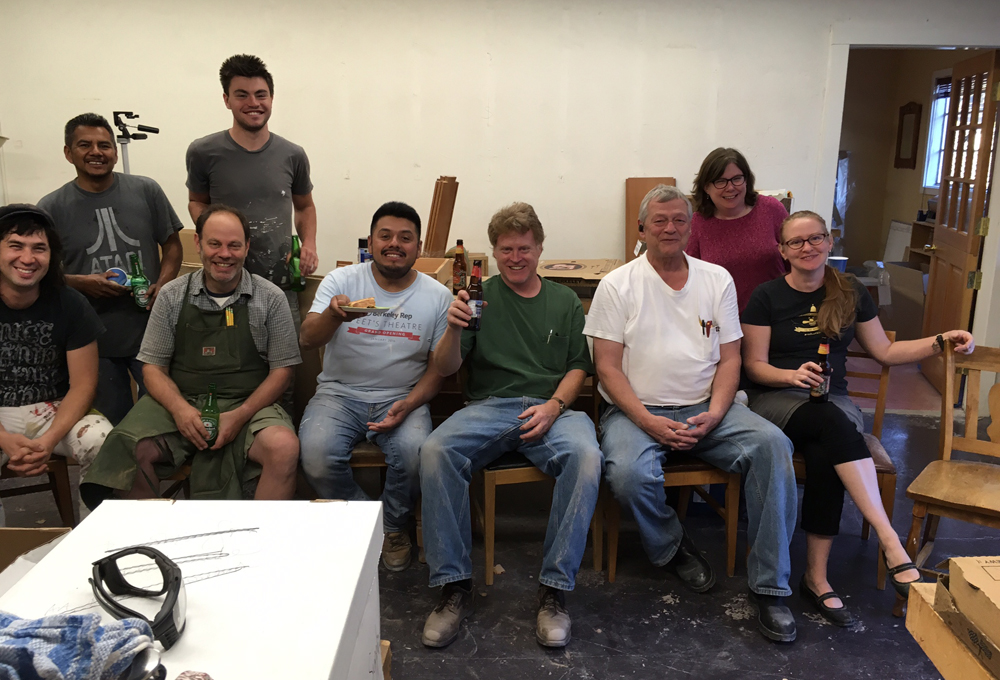 When we finally got the new space here in Berkeley, it felt like the fates were with us. No less so when Jessie Dunn-Gilbert and Sam Edie joined the team. Two new hires while undertaking an ambitious move could have spelled disaster. Instead, those two fit seamlessly with the whole group, and together—along with several other key people who helped us move, build out, and finish the new space, including Karen Gorman, Joe Pieri, Juan Lopez, and Melchor Mendiola—we made miracles happen: just seven weeks after signing the lease we opened the doors.
When we finally got the new space here in Berkeley, it felt like the fates were with us. No less so when Jessie Dunn-Gilbert and Sam Edie joined the team. Two new hires while undertaking an ambitious move could have spelled disaster. Instead, those two fit seamlessly with the whole group, and together—along with several other key people who helped us move, build out, and finish the new space, including Karen Gorman, Joe Pieri, Juan Lopez, and Melchor Mendiola—we made miracles happen: just seven weeks after signing the lease we opened the doors.
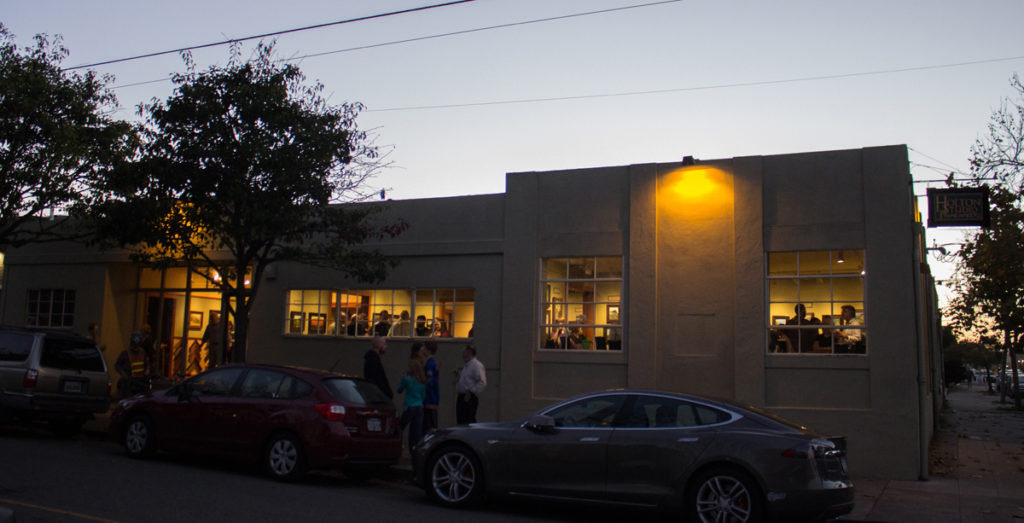
A gathering of friends and well-wishers fills our new Berkeley home for the 2016 grand opening
Of course, in the past three decades, the world has seen its share of troubles. But through my work, these years have also taught me that life is less likely to fall apart when we keep our attention on the web of life, on putting things together—on the arts, that is: the joinery and the joining of it all. Indeed, it’s been with the help of great kindnesses and more than a few of those long friendships with customers, artists, and co-workers that we’ve held it together through tough times.
Oddly, after all these years I still feel like I’m just getting started. The life so short, the craft so long to learn, the ancient saying goes. The business is still a work in progress and always will be, so long as we continue to treat the art of picture frame making as a living art—and keep adding to the family energetic, creative, and enthusiastic new members like Avi Shorer and Jonathan Wertz. But with this fabulous crew, the business is, at last, more than just a lot of parts. The parts now make up a well-joined whole. It feels substantially complete.
The root of the word complete, com-, is Latin for that lovely, short and simple joining word at the root of it all: with. It’s also the root of another word, company, which Nan Phelps, one of the artists we love to work with, captured last fall in the picture below.
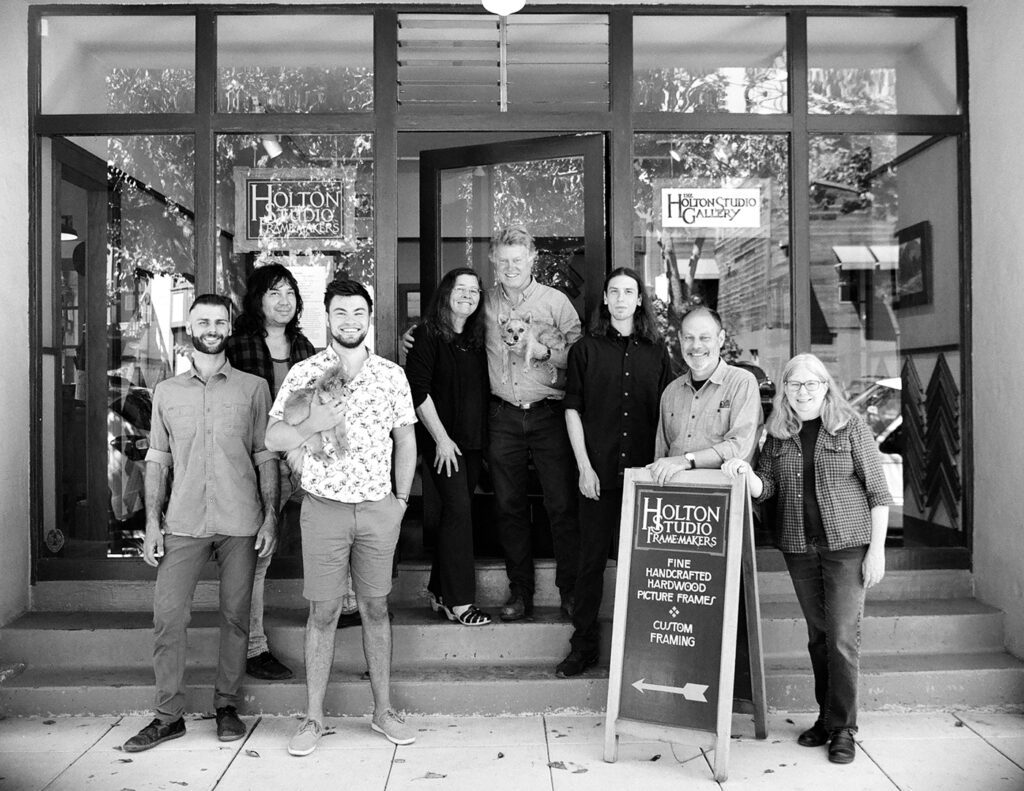
Company portrait. Left to right: Jonathan Wertz, Eric Johnson, Sam Edie (holding Milton), Stephanie McCoy, Tim Holton (holding Barb), Avi Shorer, Trevor Davis, and Jessie Dunn-Gilbert. Big thank you to photographer Nan Phelps.
So, I enter this New Year filled with gratitude for the chance to work with so many wonderful customers and artists in common cause and belief that the arts are how we join the world; and grateful especially for the joy of working with this extraordinary group (what the heck do businesses where they don’t work do?)—the company with which that lonely guy in the photo from thirty years ago now belongs.
Postscript
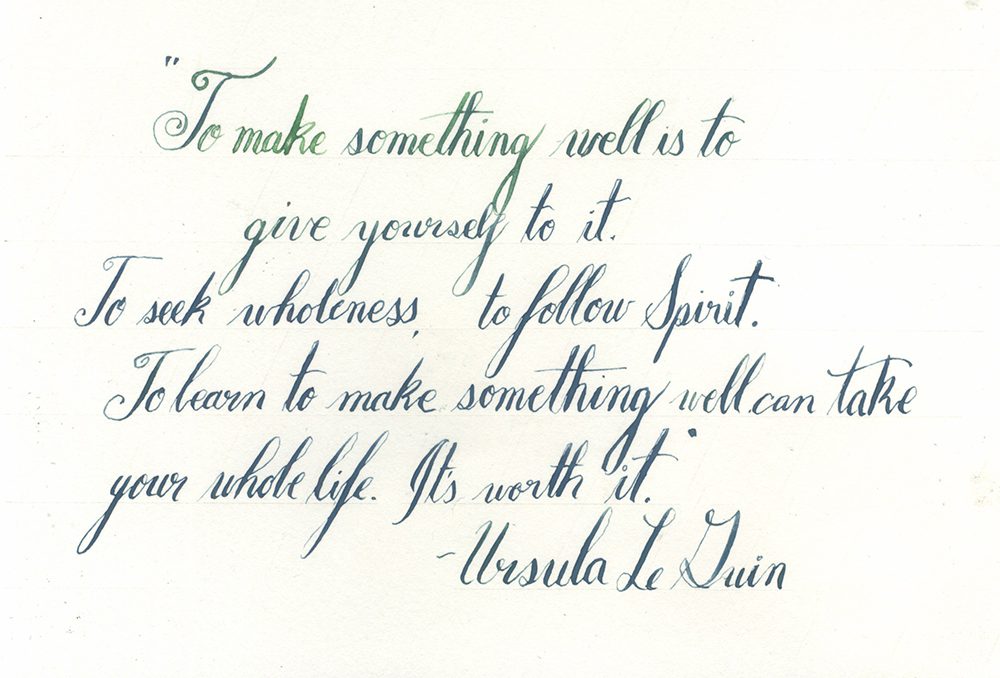
Calligraphy by Jonathan Wertz, the newest member of Holton Studio.
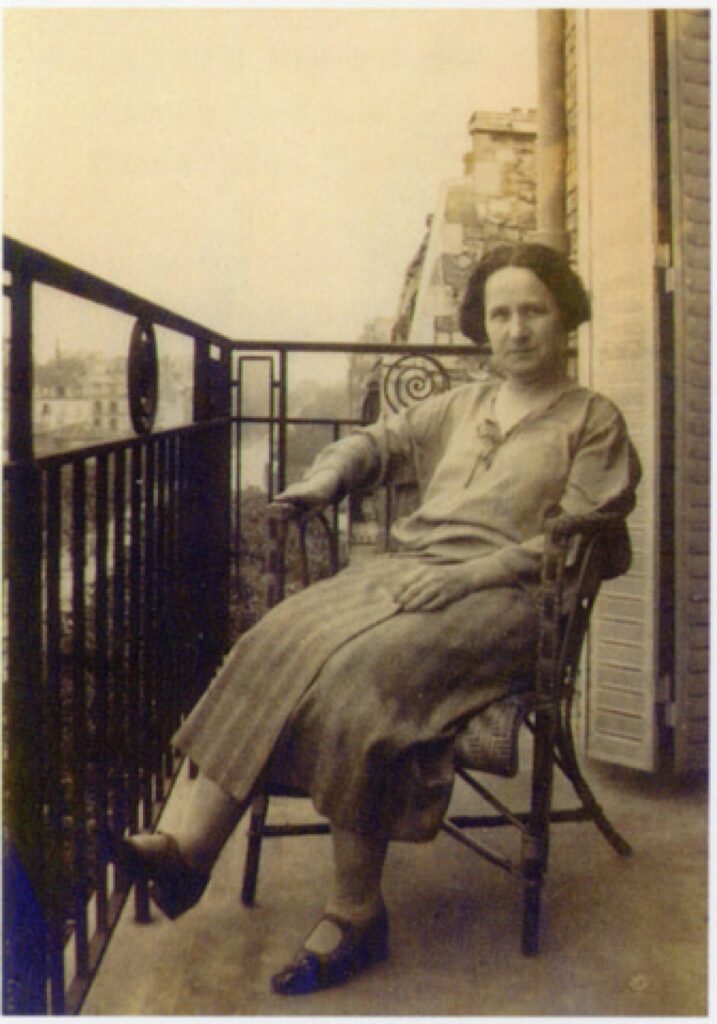 Blanche Lazell (1878-1956), a Provincetown artist best known for her white line block prints. Lazell liked to experiment and took great interest in the artistic trends of her day, as demonstrated by these two very different paintings. The contrast in style prompted two highly contrasting settings.
Blanche Lazell (1878-1956), a Provincetown artist best known for her white line block prints. Lazell liked to experiment and took great interest in the artistic trends of her day, as demonstrated by these two very different paintings. The contrast in style prompted two highly contrasting settings.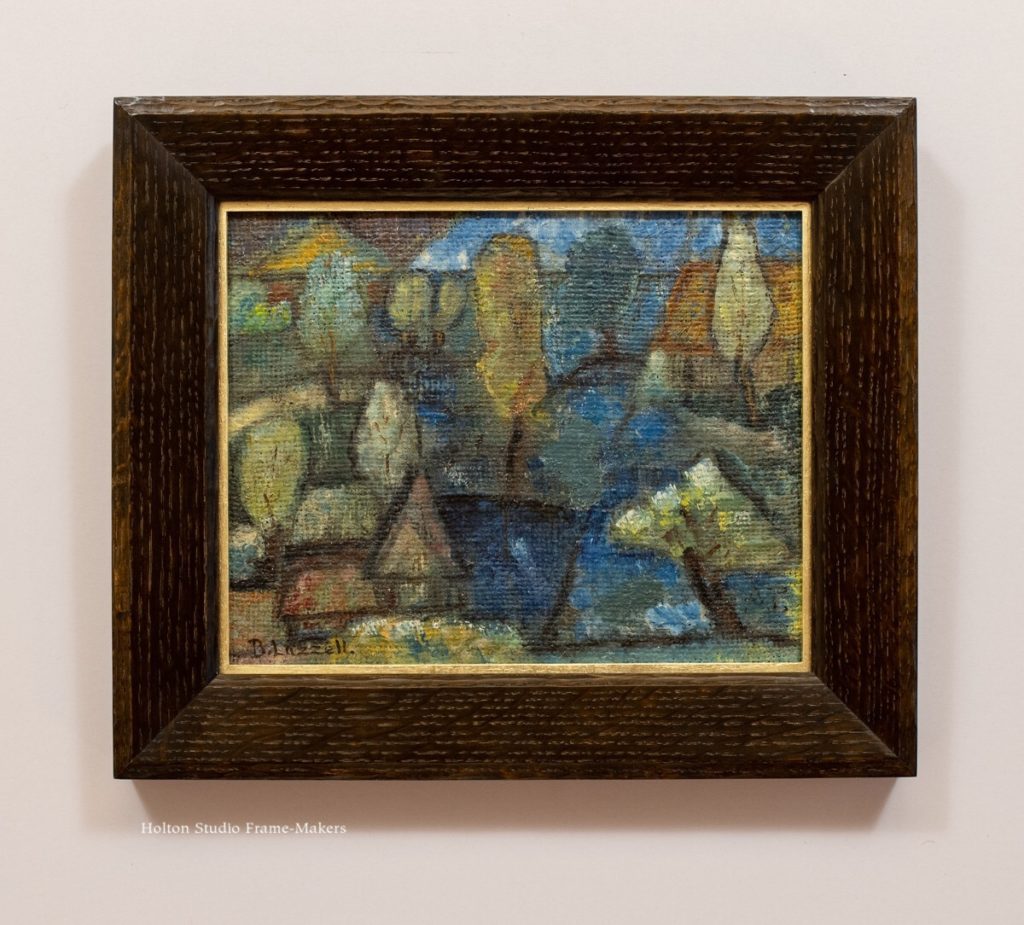 Lazell composed this second piece, which is 18″ x 14″, in cubist fashion, using very bold, hard-edged flat forms. Compared to the first painting, this one has little texture. The shapes are less angular and more rounded. It thus called for a very different frame. We made it a 2″ wide, bold, rounded corner frame in smooth walnut, stained black. Proud splines accent the corners.
Lazell composed this second piece, which is 18″ x 14″, in cubist fashion, using very bold, hard-edged flat forms. Compared to the first painting, this one has little texture. The shapes are less angular and more rounded. It thus called for a very different frame. We made it a 2″ wide, bold, rounded corner frame in smooth walnut, stained black. Proud splines accent the corners.